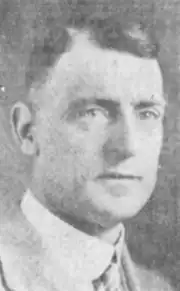Douglas Cunnington | |
|---|---|
 | |
| Member of Parliament for Calgary West | |
| In office 1939–1940 | |
| Preceded by | R. B. Bennett |
| Succeeded by | Manley Justin Edwards |
| Personal details | |
| Born | April 20, 1885 Bridgnorth, Shropshire, England |
| Died | May 9, 1973 (aged 88) Calgary, Alberta, Canada |
| Political party | Conservative Party of Canada |
| Profession | farmer |
Colonel Douglas George Leopold Cunnington (April 20, 1885 – May 9, 1973) was a farmer, advertising agent, insurance salesman, soldier and a politician at the federal and municipal levels in Canada.
Early life
Cunnington for a time lived in British Guiana, he moved to Canada in 1910 settling in British Columbia, a year later he moved east to the Calgary region and set up a dairy farm.
Military career
Cunnington joined the Canadian Forces in 1915 during World War I. He rose through the ranks to become a Colonel. He was shot and believed killed in action at Battle of Amiens. He was instead taken prisoner, and his wounds were treated by the Germans. He remained a Prisoner of War until the cessation of hostilities.[1] (In a curious incident that received attention in the press,[2] the German troops who took him prisoner left behind some of his effects. These were subsequently found, and identified, by Canadian troops who happened upon the scene. Presuming the colonel to be dead, the items were interred under a marker inscribed with his name, and a photograph taken of the grave was forwarded to Cunnington's wife. Thus, the Cunnington family possessed a photograph of what was believed to be Col. Cunnington's grave several decades before his actual death.) After being released by the Germans in 1919 Cunnington got a job as an advertising agent with the Calgary Herald. He left that position in 1926 to establish an insurance business.
Political career
Cunnington was elected to Calgary City Council for the first time in 1935 he served as an Alderman until 1939 when he made the jump to federal politics.[1]
Cunnington ran for the House of Commons of Canada in the Calgary West electoral district in a by-election held on January 28, 1939. He would replace former Prime Minister Richard Bennett as the representative for that district, by acclamation as the Liberal candidate withdrew.[3] After his acclimation Cunnington moved his family to Ottawa, Ontario he took his seat in the House of Commons of Canada on January 25, 1940 the same day that parliament was dissolved.
Cunnington would return to Calgary to contest the election be defeated by Manley Edwards a candidate from the Liberals in the 1940 Canadian federal election. In that election Cunnington ran under the National Government banner. He would not return to federal politics.[3]
References
- 1 2 "City of Calgary Aldermanic Gallery Page 107" (PDF). City of Calgary. Archived from the original (PDF) on 2007-09-27. Retrieved 2007-08-27.
- ↑ "Un colonel possede la photo de sa propre tombe, Page 9" (PDF). Le Petit Journal, June 10, 1934. Retrieved 2009-07-15.
- 1 2 "The Role of the Speaker of the House of Commons". Speaker of the Canadian House of Commons. October 25, 2001. Retrieved 2007-08-27.